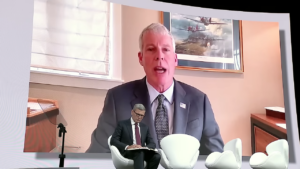A first-of-its kind demand response and battery storage project being rolled out by Melbourne-based start-up GreenSync in partnership with major utility United Energy has been named as the first recipient of the Victorian Labor government’s $20 million New Energy Jobs Fund.

A $554,886 grant for the project was announced on Tuesday at the Melbourne headquarters of GreenSync, a six-year old company whose smart energy software and hardware has seen it grow from a staff of four in 2012 to more than 30 people today, with a new office opening in Singapore.
The partnership with United Energy, which was announced last week, will see GreenSync deliver an integrated demand management solution to reduce peaks in electricity demand and network constraints in Victoria’s Mornington Peninsula region, between Rosebud and Portsea.
According to United Energy, the five-year Community Grids Mornington Peninsula project, which is the result of a Regulatory Investment Test, will defer the need for around $30 million of investment in new poles and wires.

The state government funds will be used to support the project’s first stage, a trial of which will kick off this summer. GreenSync will use the money to install two battery systems at community centres such as schools and surf lifesaving clubs to couple with existing solar PV.
The funds will also be used to pilot up to 250 Demand Response Enabled Device (DRED) control units in households across the Peninsula in the next 18 months. Through DRED control, air conditioners can have their power optimised or their use sequenced to lower peak demand when the grid is under stress. The project will demonstrate this technology, and assess the best approaches for a wider roll out across the community from 2018.
GreenSync says the broader project will ultimately engage and incentivise more than 5,000 households, businesses and community organisations to help them reduce and/or shift 11MW of energy demand at peak times through the use of solar PV and energy storage systems, as well as local utilities and other larger commercial and industrial operators to control their discretionary loads.
All things considered, the project is rather a big deal – not just in Australia, but also globally – and not least of all because it is a innovative non-network solution that has been sought and applied by a “traditional” network business.
“This is about using different technologies to achieve the same result… in a cheaper way, in a way that is more flexible and nimble and in a way that delivers a cheaper and more affordable set of solutions,” said state energy minister Lily D’Ambrosio in comments at the announcement on Tuesday morning.
“United Energy (is) probably the first distribution business in Victoria to actually recognise these technologies as an alternative to what normally happens, to the solutions that distribution businesses go to for constraints along the network, but you also embraced it and decided to change the way you relate with these technologies,” she said.
“That’s not just the future, that’s the here and now. And unless a number of our key regulators, and …traditional businesses understand that, then we are going to miss so many vital opportunities to better manage our energy networks, to provide real choice and affordable and clean energy solutions for our consumers and the significant investment opportunities and jobs that come with all of that.”
GreenSync managing director and co-founder Phil Blythe said the project was significant as one of the first examples in Australia where the issue of gold-plating of the nation’s electricity networks was being addressed, head on.
“We’re actually finding an alternative, together with the community – and that’s a really important part, it takes community participation – but we’re working together with all the stakeholders to find a commercially viable alternative to and practical alternative to that gold-plating issue,” he said on Tuesday.
“We’re commercially working with United Energy (and have) put together a plan for the community which allows us to use alternative technologies.
“So we’re deploying battery storage systems, we’re putting in remote control devices in air-conditioning, we’re controlling pumps – … it’s the smarts, basically, and that’s what we do as a team, is to provide a smart layer of control that during those very few, infrequent hot events we’re able to smooth out the loads and avoid added infrastructure.”
United Energy’s Andrew Schille said the partnership with GreenSync was part of a bigger reform package the distributor was undertaking, including the roll out of smart meters and the coming introduction of demand tariffs, all of which would benefit consumers in the long run.
“It’s no secret that the energy landscape is changing quite significantly,” Schille told the gathering on Tuesday. “We’re really grabbing that challenge head on and partnering with companies such as GreenSync.
“(This project) is $30 million (of avoided infrastructure) and that will be passed on to customers at the next price review and that’s a really good outcome for everyone involved,” he said.
“Projects like these certainly make our shareholders happy. We’re interested in deferring capex as much as we can because the shareholders don’t want us to spend money when there’s no need, and when there’s better opportunities available.”










